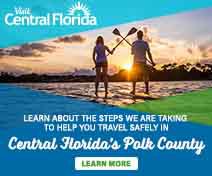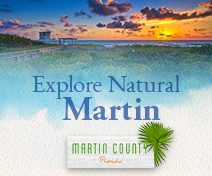HISTORY

Sunshine State Chronicles
Florida’s history is an intriguing one, filled with swashbuckling tales of Spanish adventurers, legendary Civil War battles and U.S. astronauts’ pioneering ventures into space. American, African American and Hispanic cultural sites bring Florida’s past to life while coastal forts, lighthouses, museums, mansions and vintage hotels showcase historic treasures for all to view.
Southeast
Thousands of years before the first European explorers arrived, Florida was populated by Native Americans such as the Tequesta people who lived near the mouth of the Miami River. The Miami Circle is an archaeological site in downtown Miami believed to have been a structure built by these people.
Other Native American cultures survived the incursion of northern settlers in the 1800s by moving into the Everglades, where they gradually rebuilt their societies. Now, visitors can learn about the Seminole and Miccosukee Peoples, sample Indigenous cuisine, take a ride on an airboat or watch alligator wrestling at attractions along U.S. 41 (Tamiami Trail) and I-75 (Alligator Alley). Clewiston’s Ah-Tah-Thi-Ki Museum is a living village of early Seminole culture.
To help mariners avoid rocks and reefs, several lighthouses were erected in this region in the 1800s. For a fascinating glimpse into Florida’s past, tour the Garden Key Lighthouse at Fort Jefferson and nearby Loggerhead Key Lighthouse (both in Dry Tortugas National Park); the Cape Florida Lighthouse on Key Biscayne near Miami; and the 164-year-old Jupiter Inlet Lighthouse and Museum in The Palm Beaches.
Built in 1891, the Museum of Art & History at the Custom House in Key West houses exhibitions exposing visitors to a Florida they may have never known. Clinton Square Market, now a two-story shopping mall, is housed in an 1800s building that was once a U.S. Navy coal depot. Historic Key West also offers the Harry S. Truman Little White House presidential museum and the Ernest Hemingway Home & Museum.
Miami’s historic Lyric Theater was a major entertainment center for African Americans in one of the city’s first Black neighborhoods when the theatre opened in 1913. A few blocks to the south, Little Havana reflects Miami’s Cuban heritage, with restaurants, clubs and shops.
Pioneer homes and historical hotels are found in Fort Lauderdale, Boca Raton and West Palm Beach. Two examples are Historic Stranahan House Museum on the New River in Fort Lauderdale and the Bonnet House Museum & Gardens near the Intracoastal Waterway. In The Palm Beaches, the Boca Raton, the Colony Hotel & Cabaña Club in Delray Beach and the world-famous Breakers Hotel in Palm Beach are examples of Florida architecture from the 1920s.
Southwest
Inventor Thomas Edison and his friend Henry Ford built their Florida homes in Fort Myers. The compound is known today as the Edison & Ford Winter Estates and features a museum, laboratory and gardens.
To the north, not far from the historic Boca Grande Lighthouse in Gasparilla Island State Park, the Gasparilla Inn & Club has attracted visitors since 1913.
Koreshan State Historic Site in Estero was the scene of one of the most unusual chapters in Florida history. In 1894, Cyrus Reed Teed founded the Koreshan Unity, a community of followers who believed the universe existed within a giant, hollow sphere. Today, the site has 11 well-maintained historical structures dating from 1882–1920 as well as landscaped grounds with exotic ornamental plants from around the world.
In Bradenton, the Gamble Plantation Historic State Park is the only remaining antebellum plantation house in South Florida. Nearby, the town of Palmetto boasts its own historical park, as well as an ancient Native American landmark, the Madira Bickel Mound State, considered Florida’s first archaeological site.
Farther north in Sarasota, The Ringling, which is the state art museum of Florida, is a standing legacy to the rich history of the American circus and houses a wealth of artifacts, including the world’s largest miniature circus. Surrounding gardens feature an extensive variety of native and exotic trees and the Mable Ringling Rose Garden.
Central East
In 1949, Cape Canaveral became a test site for the U.S. missile program. A decade later, the Cocoa Beach-Titusville area was the heart of the nation’s space program, including Apollo 11, the 1969 mission that carried astronauts Neil Armstrong and Buzz Aldrin to the moon. Now, the Kennedy Space Center Visitor Complex allows guests to experience the glory years of the U.S. space program.
Located on the U.S. Air Force Base is the historic Cape Canaveral Lighthouse; be sure to check tour information before planning your trip.
To the north, the Ponce de Leon Inlet Lighthouse & Museum guards the waterway at the southern end of the Daytona Beach area.
Central
For a survey of Central Florida’s fascinating past, visit the Orange County Regional History Center in Orlando to view exhibits such as a typical pioneer home from the 1800s.
One of Florida’s leading African Americans was Zora Neale Hurston, a prominent 20th-century author whose works influenced such writers as Toni Morrison and Ralph Ellison. A festival season in Eatonville that celebrates 35 years in 2024 showcases her life and her contributions to literature.
West Central
Located in Tampa’s Channelside District, the Tampa Bay History Center houses 60,000 square feet of exhibits that link the region’s modern culture with sports legends, railroad tycoons, cattle drives, pioneers, Spanish conquistadors and Florida’s first Indigenous groups. It’s a short drive to Ybor City, known as Tampa’s Latin Quarter for more than a century. Visitors can enjoy Cuban coffee and cigars and dance to Latin rhythms.
The Don CeSar Hotel, in St. Petersburg Beach, is known as “Florida’s Pink Castle” since it opened in 1928. Another Florida treasure is Tarpon Springs, where visitors can tour the historical sponge diving docks.
Northwest
One of the nation’s oldest cities on the Gulf Coast, Pensacola has flourished under Spanish, French, British, Confederate and U.S. rule, and today is known as the “city of five flags.” At its heart, Historic Pensacola Village, operated by the University of West Florida, includes 28 properties, 11 of which are open to the public.
In the late 1500s, the Spanish first inhabited the region to protect their settlements and galleons carrying gold from Mexico. Storms, battles and other accidents resulted in numerous sinkings, and divers today can explore 20 wrecks along the Florida Panhandle Shipwreck Trail between Pensacola and Port St. Joe. Visitors can also tour historical lighthouses in the region, such as the Pensacola Lighthouse and Maritime Museum, built in 1859.
In the 1700s, the British took control of the region, later building Fort George (c. 1778).
Then, a Spanish army with U.S. volunteers ousted the British forces during a 1781 battle—a little-known victory of the American Revolution.
North Central
During the early 1800s, Florida’s population was concentrated in North Florida, where Tallahassee became the territorial capital. One of the city’s highlights from that era is the Call-Collins House at The Grove Museum, an historic mansion finished in the 1840s by Richard Keith Call, an aide and advisor to General Andrew Jackson.
When the Civil War broke out in 1861, Florida joined the Confederacy—the smallest state to secede from the U.S. During the war, Union troops fought the Confederates in several clashes in the North Central area, including the Battle of Natural Bridge in 1865—one of the last Confederate victories in the war. To the south near Lake City, “soldiers” in Civil War uniforms annually re-enact the Battle of Olustee. The state also publishes the Florida Civil War Heritage Trail, a guidebook to Florida battle sites.
Southwest of Tallahassee, visitors can tour the charming fishing community of Apalachicola, the center of the state’s oyster industry for many decades. Nearby is the St. Marks Lighthouse in St. Marks National Wildlife Refuge.
Northeast
Back in 1513, Spanish explorer Juan Ponce de León set foot on Florida’s sandy shores and christened the new land “La Florida.” Four decades later, Pedro Menéndez de Avilés founded St. Augustine, the oldest continuously inhabited European-established city in the U.S. Featuring an historic district containing some 30 colonial-era buildings, St. Augustine provides a unique glimpse into Spanish colonial life. Highlights include Castillo de San Marcos, the oldest masonry fortification in the continental U.S., and the St. Augustine Lighthouse & Maritime Museum.
In 1738, in an attempt to destabilize the plantation economy of the British colonies by creating a free black community to attract slaves seeking escape and refuge, the Spanish established the fort and town of Gracia Real de Santa Teresa de Mosé, commonly known as Fort Mose, the first free black settlement in North America.
To the north, Jacksonville traces its roots to the French who landed at the mouth of the St. Johns River in 1562 and founded Fort Caroline two years later. However, a Spanish force soon captured the fort, and the French became a distant memory. Through the years, the Spanish maintained control of the region, establishing forts, farms and missions, including Fort Caroline and the Kingsley Plantation House (c. 1798), both of which are located in the Timucuan Ecological & Historic Preserve—considered one of the last unspoiled coastal wetlands on the Atlantic coast.
One of Florida’s hidden treasures is Fernandina Beach on Amelia Island, north of Jacksonville. Many buildings in its 50-block historical district are on the National Register of Historic Places. Visitors can also tour the Amelia Island Lighthouse property. Built during the Territorial Period in 1838, it is the state’s oldest lighthouse. Scout out Fort Clinch for a glimpse into the nation’s past during the Civil War.










